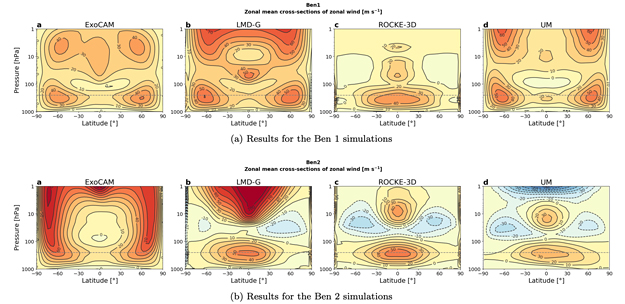The TRAPPIST-1 Habitable Atmosphere Intercomparison (THAI). Part I: Dry Cases — The Fellowship Of The GCMs

With the commissioning of powerful, new-generation telescopes such as the JWST and the ELTs, the first characterization of a high molecular weight atmosphere around a temperate rocky exoplanet is imminent.
The best target we have so far of a potentially habitable planet accessible to these telescopes is TRAPPIST-1e. Numerical atmospheric simulations and synthetic observables of such targets are essential to prepare and eventually interpret these observations. Here we report the results of the first part of the THAI (TRAPPIST-1 Habitable Atmosphere Intercomparison) project, which compares the results of 3D numerical simulations performed with four state-of-the-art Global Climate Models (ExoCAM, LMD-Generic, ROCKE-3D, Unified Model) for TRAPPIST-1e. In this first part, we present the results of dry atmospheric simulations.
These simulations serve as a benchmark to test how radiative transfer, subgrid-scale mixing (dry turbulence and convection) and large-scale dynamics impact the climate of TRAPPIST-1e and consequently the transit spectroscopy signature as seen by JWST. To first order, the four models give results in fairly good agreement. The inter-model spread in the global mean surface temperature amounts to 7K (6K) for the N2-dominated (CO2-dominated, respectively) atmosphere. The radiative fluxes are also remarkably similar (inter-model variations < 5%), from the surface up to ~5 millibar.
Moderate differences between the models appear in the atmospheric circulation pattern and the (stratospheric) thermal structure. These differences arise between the models from (1) large scale dynamics because TRAPPIST-1e lies at the tipping point between two different circulation regimes (fast and Rhines rotators) in which the models can be alternatively trapped ; and (2) parameterizations used in the upper atmosphere such as numerical damping (e.g., the presence and formulation of a sponge layer).
Martin Turbet, Thomas J. Fauchez, Denis E. Sergeev, Ian A. Boutle, Kostas Tsigaridis, Michael J. Way, Eric T. Wolf, Shawn D. Domagal-Goldman, François Forget, Jacob Haqq-Misra, Ravi K. Kopparapu, F. Hugo Lambert, James Manners, Nathan J. Mayne, Linda Sohl
Comments: Submitted to the Planetary Science Journal as Part I of a series of 3 THAI papers. Comments on the manuscript are welcome
Subjects: Earth and Planetary Astrophysics (astro-ph.EP); Atmospheric and Oceanic Physics (physics.ao-ph)
Cite as: arXiv:2109.11457 [astro-ph.EP] (or arXiv:2109.11457v1 [astro-ph.EP] for this version)
Submission history
From: Martin Turbet
[v1] Thu, 23 Sep 2021 16:03:49 UTC (22,466 KB)
https://arxiv.org/abs/2109.11457
Astrobiology








